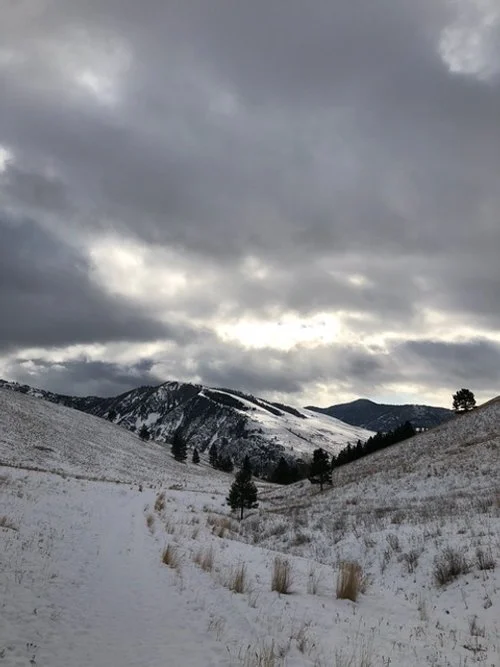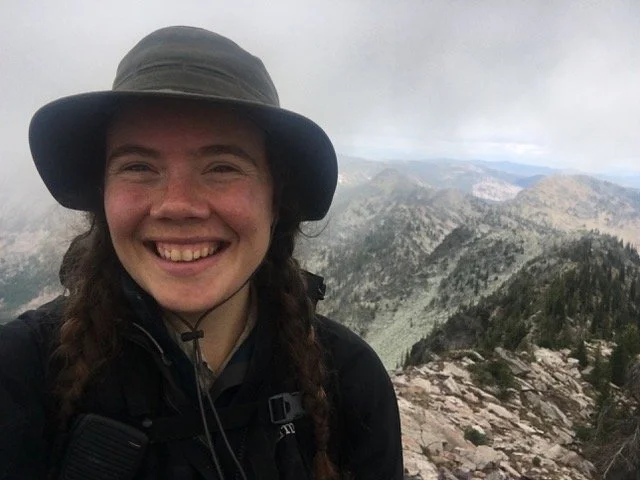Where Climate Justice Meets Disability Justice
By Sarah Capdeville. This article was originally published in The Changing Times, a quarterly magazine from Families For a Livable Climate which features original art and writing from Montanans of all ages and backgrounds who are responding to the climate crisis.
The elk, that winter morning, were acting odd. The sky was, too, ballooning cobalt behind wedges of stratus to the north. And so was my body, heavy with an ache like hot aluminum foil packed against my limbs—but that, at least, was pretty normal.
My dog and I were headed down the wind-rounded crest of Waterworks Hill, and as usual, I had my focus turned to Mount Jumbo, where I could make out half of the winter elk herd grazing below the treeline. The other half, though, had moved all the way up the mountain, almost to its summit, bunched together on the snowy ridge like a row of sentries.
Over the Rattlesnake Mountains to the north, where the elk spend the rest of their year, tangles of clouds stretched thin against a wall of deep blue. The air—its color, its hollow stillness—spoke of an approaching front. And my body, with its low buzz of fatigue from autoimmune disease, was a mirror to that pressure drop. I’d seen the forecast earlier, but now I was enveloped in it—the looming cobalt horizon, the elk clustered on Jumbo’s crest, the cells of my immune system, also on edge.
It’s nearly impossible to attribute any single storm to climate change. And this winter storm, in particular, was more of a norm and a necessity to the Northern Rockies than an outlier. Still, when it comes to any dramatic swing in weather these days, I can’t help but think of the reality of climate change: more severe storms, more floods, more wildfires, more drought, more moisture churned up into the atmosphere, sometimes dropping on the right places, sometimes not. Even as more people experience these events firsthand, moving the abstract into physicality, I can’t help but think of the unavoidable physicality of climate change for chronically ill and disabled people.
Conversations on climate change often reflect broader societal and systemic inequities, and the exclusion of chronically ill and disabled voices in these conversations is no exception. Last year, on the first day of COP26 in Glasgow, Scotland, the energy minister of Israel, Karine Elharrar, was unable to participate in the talks because the building was unaccessible for wheelchair users. In recent years, movements to ban plastic straws have continually overlooked and silenced people with disabilities who rely on single use, plastic straws to safely consume liquids. Conversations about the staggering carbon footprint and environmental impacts of different food industries often shame disabled and chronically ill people for dietary needs that are out of our control.
In these examples, a troubling narrative crops up—that accessibility and addressing climate change are at odds. This perspective not only isolates disabled and chronically ill people from engaging critically in conversations about our shared futures, but fuels real-world harm. In 2013, a federal judge found that New York City had discriminated against disabled residents in its failure to include them in rescue and recovery plans after Hurricane Sandy; similarly, the National Council on Disabilities wrote that “people with disabilities, especially those living in poverty, were disproportionately left behind in Hurricane Katrina.” In 2019, when California’s Pacific Gas & Electric cut power across the state in the face of extreme wildfire conditions, it failed to communicate those shut-offs to hundreds of customers living with chronic conditions. One of them, a man named Gerald Niimi, suddenly found himself without a functioning ventilator. He died after two days of searching for one in vain.
The lack of preparedness, response, effective communication, and intentionality for those living with chronic illness and disability in the wake of these disasters point to how broad lack of accessibility compounds in the face of climate change. Equally important, too, is how a changing climate directly impacts chronic illnesses and disabilities in the body. Maintaining some semblance of balance on an individual level is a daily struggle for many chronically ill and disabled people, and adding climate change driven events drastically tips the scale. During record-setting temperatures in July of 2018 in Montreal, a quarter of all people in emergency rooms had schizophrenia, 500 times higher than their representation in the general population. These people were facing highly disproportionate rates of heat-related illnesses because their medications used to manage schizophrenia heightened susceptibility to heat, further compounding social stigma and isolation.
Heatwaves in general, increasingly common in our warming world, are especially damaging for those with chronic and underlying conditions. Last June, when a heatwave inundated much of the Northern Rockies and Pacific Northwest, I felt my body reach its tipping points, one after another, until they were all knocking against each other in my non-air-conditioned Missoula home. Chronic inflammation means I struggle to regulate my temperature, and with outside temperatures scaling into triple-digits, my blood flow scattered like fast snowmelt. Heartbeats pattered in matching triple-digits. Blood and oxygen drained from my digestive system and brain, leaving me nauseous, spacey, weary. Side effects from my own medication worsened. Sleep was fitful, fleeting, sweat-drenched. All this deregulation of various systems put further stress on my immune system, which tripped into a stronger flare of autoimmune disease activity, which, in turn, exacerbated the imbalances we were all struggling with that week in late June.
A metaphor often used in conversations about climate change is the snowball effect—this idea that the more momentum gained, the harder it is to stop, and the more damaging any impacts will be. But the scope and starting points of that complex snowball often fail to take into account vulnerabilities present to begin with. And when it comes to the absence of disability justice in conversations about climate change, that means that those and other inequities will continue to silently parallel—and never rightfully intersect—with the individual and systemic injustices exacerbating them in the first place.
“I can sense a wildfire coming before most people because of how my respiratory system is built,” writes disability rights advocate Alice Wong. “My diaphragm, which is slowly weakening over time, gives me a heightened sensitivity to secrets in the air.” Disabled and chronically ill bodies and minds are barometers to change at the smallest scales, and above all reflect the complexity of how that smallness augments a larger whole. Excluding the needs and wellbeing of disabled and chronically ill people in climate change disaster preparedness, recovery, and mitigation is a direct result of ignoring these perspectives, especially from Black, Indigenous, and other people of color. Climate change is already further marginalizing disabled and chronically ill populations; disability justice demands that our individual and collective responses stop doing the same.
That afternoon on Waterworks Hill, in the presence of the elk and deep swath of sky, my body pulled attention to the moment before the snow started falling. And I was grateful, despite the growing fatigue that would later drop me to the couch as pointedly as the storm ricocheting outside, for the physicality of that moment, surrounded by secrets and sentries of land and body. I was grateful to be intertwined—rather than at odds—with the larger world, even as it continued and continues to snowball in so many ways.
—
Sarah Capdeville is a nonfiction editor at The Hopper. Her writing has been published in Orion, The Normal School, Flyway, Fourth Genre, Camas, and others. Always in search of wild places, she's rambled high desert, glacial basins, and boreal forests two-hundred miles north of the arctic circle. Currently, she lives in Missoula with her partner, greyhound, and chaotic kitten, where she navigates chronic illness and daydreams about the crosscut saw.

